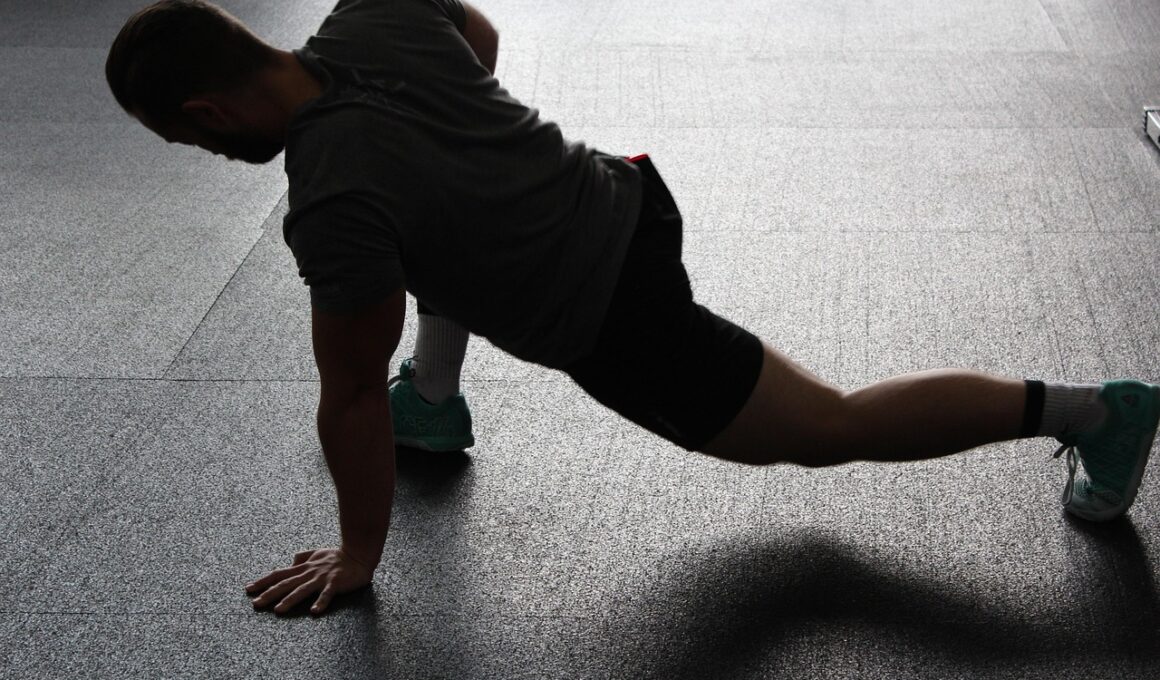Dynamic Warm-Ups for Basketball Players to Improve Performance
Every basketball player understands the importance of proper warm-ups. Dynamic warm-ups enhance performance by preparing the body for rigorous activity. They increase blood flow to muscles, improve flexibility, and maximize range of motion. Furthermore, they play a significant role in reducing the risk of injuries. Dynamic stretches are particularly beneficial for basketball players, as they involve movement, making them more effective than static stretching. Instead of holding stretches, players should engage in continuous motion exercises. This method actively engages muscle groups useful during games and practice sessions. As a result, players feel more agile, responsive, and ready to perform. Effective dynamic warm-ups include leg swings, walking lunges, and arm circles. Each exercise targets specific muscle groups essential for basketball. Implementing a comprehensive dynamic warm-up routine not only boosts muscle readiness but also sharpens mental focus. Players should dedicate at least 15 to 20 minutes prior to each training session or game for a complete warm-up. By fully embracing this practice, players can set themselves up for better performance and increased enjoyment during games.
Key Exercises in Dynamic Warm-Ups
Incorporating key exercises during dynamic warm-ups ensures that players activate their major muscle groups effectively. Exercises like high knees and butt kicks are fantastic for elevating heart rates while simultaneously enhancing coordination. High knees, performed by lifting knees towards the chest, engage the hip flexors and quadriceps, crucial for explosive movements on the court. Butt kicks, on the other hand, focus on the hamstrings, helping to develop proper running mechanics. Another beneficial exercise includes arm swings which promote shoulder mobility. This is vital for shooting and passing accuracy. Lunges with a twist can further enhance overall flexibility and core strength. Players should also incorporate lateral movements such as carioca and side shuffles, mimicking side-to-side movements crucial in basketball. These exercises will not only enhance performance on the court but also support agility. Incorporating balance exercises like single-leg stands into the routine will significantly improve stability. Stability plays a critical role while making quick movements during play. As players integrate a variety of these exercises into their warm-up, they prepare better for intense gameplay.
Furthermore, addressing specific basketball-related movements is essential in dynamic warm-ups. Players should include drills targeting shot preparation and defensive stances to enhance muscle memory. Incorporating layup drills during warm-ups can effectively bolster footwork and technique. A solid layup requires coordination between the legs and upper body. In addition, performing defensive slides will develop lateral quickness, crucial when guarding opponents. A warm-up session can also include short sprints to build speed. This way, players acclimate their bodies to changes in velocity and direction. It is important to balance intensity and duration of each exercise. Players must ensure they are warmed up, without exhausting themselves prior to practice or games. Coaches may assist in developing a structured warm-up routine specific to their team’s needs. Customization ensures that players are prepared for their unique challenges on the court. Additionally, introducing elements of competition during warm-ups can keep players engaged. Incorporating friendly rivalry, like races or shooting contests, helps foster teamwork. By focusing on basketball-specific warm-ups, players can approach their training sessions with a competitive edge.
The Importance of Cool-Downs
After an intense workout or game, cooling down is just as crucial as warming up. A proper cool-down helps in recovery and reduces muscle soreness following rigorous activities. It aids in flushing out lactic acid, which can build up during intense physical exertion. This benefits athletes by promoting faster recovery times and reducing stiffness. A cool-down should focus on static stretching, allowing muscles to relax gradually. Spending time on areas like the quadriceps, hamstrings, and calves will help in maintaining flexibility. In addition, players should engage in deep breathing exercises to encourage relaxation and mental clarity. Taking 10 to 15 minutes for a cool-down will ensure that players enhance their recovery process significantly. They should also incorporate foam rolling to release muscle tension effectively. Cohesively integrating cool-downs into the training routine nurtures the players’ long-term physical health. It minimizes the chances of injury that could arise from overexertion. Overall, acknowledging the value of both warm-ups and cool-downs is essential for every basketball player focused on maximizing their performance.
Moreover, hydration plays a vital role in both warm-ups and cool-downs. During dynamic warm-ups, athletes sweat, leading to a loss of fluids. Adequate hydration before and after the session aids in maintaining optimal performance levels. Players fuel their bodies by drinking water or sports drinks containing electrolytes. Electrolytes help sustain energy levels during warm-ups, and sports performance overall. Coaches should emphasize the importance of hydration as part of an athletes’ routine. Players should be educated on the signs of dehydration which can affect their performance. This includes understanding symptoms like excessive fatigue, dizziness, and muscle cramps. Implementing scheduled water breaks during training sessions will help reinforce the habit. Encouraging players to carry their own water bottles during practices also promotes responsibility for their health. Proper hydration is a crucial aspect of performance training. In doing so, athletes cultivate better awareness of their physical state. As a result, they maintain higher energy levels during games and practice sessions. It’s essential for players to view hydration as a core component of their overall training strategy.
Combining Warm-Ups with Skill Development
Dynamic warm-ups should go beyond simple stretches; they must also seamlessly integrate skill development exercises. Players can elevate their game by practicing dribbling or shooting as part of their warm-up routine. Combining skills with physical readiness promotes muscle memory that builds confidence. For example, performing shooting drills while doing layup combinations capitalizes on time. This embeds skill practice within the warm-up session. Incorporating passing drills enhances teamwork and communication, crucial elements existing within the framework of basketball. As players warm up together, they familiarize themselves with each other’s gameplay, creating better on-court chemistry. Coaches can also introduce situational drills that mimic game scenarios, further enhancing readiness. Incorporating dynamic warm-ups within skill sessions encourages engagement among players. Additionally, these practices maintain a competitive spirit while minimizing monotony. Customizing warm-ups to fit various positions will stimulate individual improvement. Players must remember that effective warm-ups are more than routine; they represent the first crucial steps in their performance journey. By investing time and effort into dynamic warm-ups, athletes can take their on-court performance to unprecedented heights.
Ultimately, communication is essential during dynamic warm-ups, particularly in team environments. Encouraging players to give feedback during the warm-up promotes active involvement. This ensures everyone is engaged and mentally alert for practice or games. Coaches should use this time to re-emphasize the objectives for the upcoming session. Consistently reinforcing goals cultivates a sense of purpose among players. It can create accountability and motivation, further enhancing performance. Players are more likely to stay focused on their training goals when they understand their significance. Furthermore, integrating music into warm-up sessions can boost motivation and energy levels. Many players respond well to music, which stimulates a positive atmosphere. As they enjoy and connect with the warm-up sessions, players can enhance their overall enthusiasm and commitment. It is important to foster an enjoyable experience while ensuring productivity during warm-ups. The ultimate goal remains clear: prepare each player for the upcoming challenges on the basketball court. By cultivating a culture around effective warm-up routines, teams can enhance their performance and establish lasting athletic success.
Conclusion
In conclusion, dynamic warm-ups are essential for basketball players dedicated to improving their overall performance. By implementing comprehensive routines, players unlock their potential for agility, strength, and endurance on the court. Incorporating key exercises directly correlates with success in training and gameplay. Furthermore, acknowledging the importance of hydration, cool-downs, and skill development ensures players maintain a holistic approach to their athletic training. Players should see warm-ups not just as a routine but as a significant component of their preparation. Coaches play a vital role in tailoring warm-up strategies to fit the needs of their players. Through creativity and engagement, dynamic warm-ups can become enjoyable and beneficial. Ultimately, when players treat warm-ups with intention, they cultivate a foundation for success in every game. This culture of preparation fosters resilience and adaptability. Players experience growth while enjoying the journey to improved performance. Building these habits today sets athletes up for long-term success, both on the court and in life. Embracing the power of dynamic warm-ups will lead to absolute greatness in basketball.





